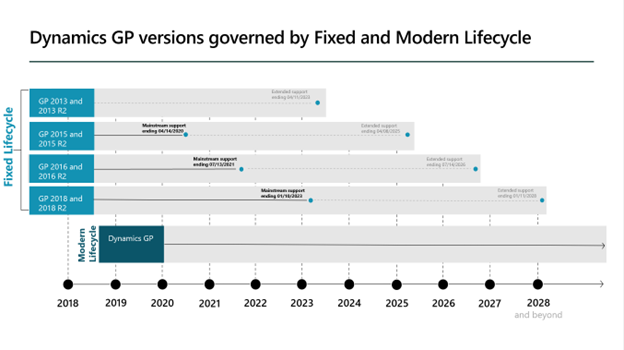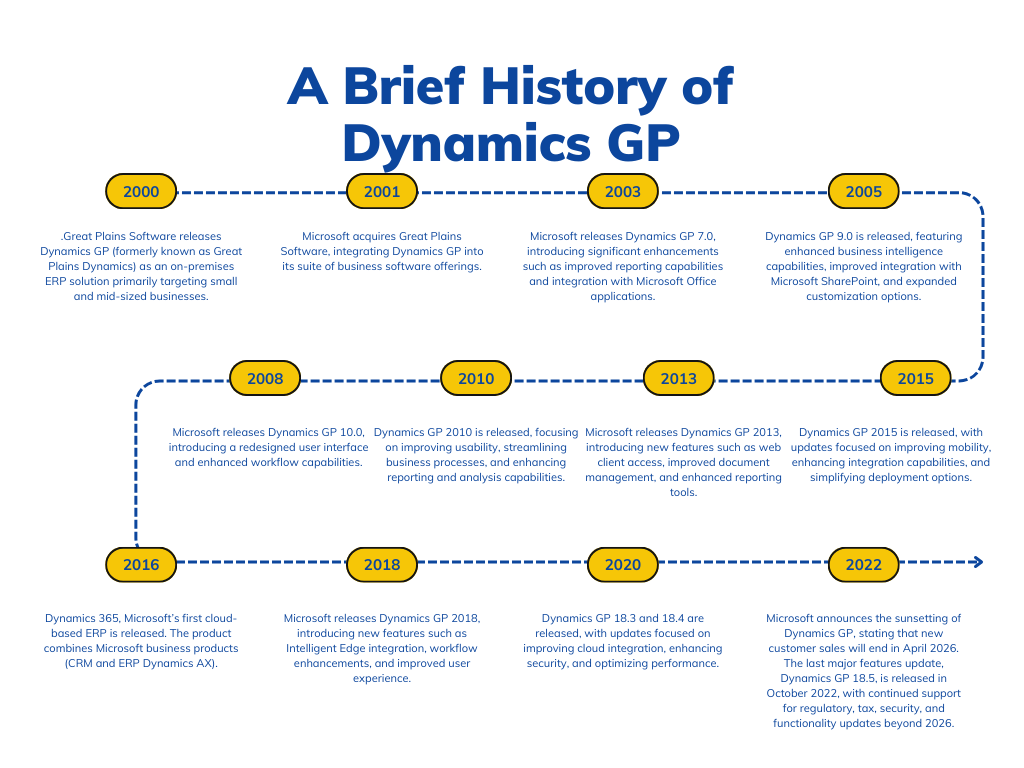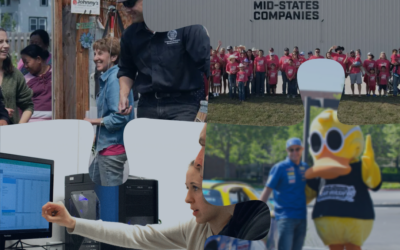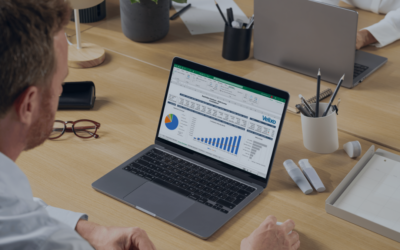Introduction
Navigating through a sunset can be as beautiful as it is disconcerting, especially when it involves a trusted ERP system like Microsoft Dynamics GP. Sink or swim, renew or replace, leap into the unknown or cling onto the familiar? Caught at this ERP crossroads, your existential business question echoes in the tech twilight.
Through Intelligent Technologies, Inc.’s journey of 3 decades in ERP landscapes, we’ve witnessed industry giants fall and new heavyweights rise, with each epoch defined by seismic shifts in how businesses operate. When we talk about the sunsetting of Microsoft Dynamics GP, we’re talking about thousands of businesses scrambling to decide.
But fret not, because what’s on the horizon isn’t necessarily twilight, but could very well be the dawn of something better.
Understanding the Microsoft Dynamics GP Sunsetting: A Comprehensive Guide
- Get to grips with what the “sunsetting” of Microsoft Dynamics GP entails.
- View a timeline outlining the phasing out of this system.
- Examine the implications for businesses using this platform.
What Does Microsoft Dynamics GP Sunsetting Mean?
The term ‘sunsetting’ in the tech industry often elicits mixed reactions. For some, it’s a necessary step towards innovation and growth. For others, it’s a disruptive process that upsets established operations. With Microsoft Dynamics GP, its sunsetting refers to the gradual phase-out of this product from Microsoft’s active product list, and the eventual cessation of support and updates for it.
For those who’ve been banking their operations on this platform, this doesn’t spell doom. Rather, it’s an opportunity to reevaluate the needs of the business and potentially transition to a more fitting solution. Microsoft’s commitment to its customers ensures they will guide them through this transition, offering more up-to-date, cloud-based systems.
Timeline of Microsoft Dynamics GP Sunsetting
Dates are vital when planning for changes. So, to help loyal GP users make an informed choice, Microsoft has recently unveiled a strategic timeline for the sunsetting of Microsoft Dynamics GP, marking a significant shift in the future of this enterprise resource planning (ERP) solution. The announcement specifies Microsoft will discontinue new customer sales of Microsoft Dynamics GP as of April 2026. Sales for subscription licensing, and perpetual licensing sales will be halted earlier, concluding in 2025. Existing customers, however, will maintain the ability to purchase new licenses and modules beyond the 2026 cut-off date.
With that said, it’s important to note there will be no more major feature updates. Support will continue for the foreseeable future as regulatory, tax, security, and functionality updates. So, for many long time Dynamics GP users, this news raises the question, “Is Dynamics GP still the best platform on which to run our business, or should we switch to another tool that can better keep up with technology advancements?” If you can relate, keep reading.
Implications of Microsoft Dynamics GP Sunsetting for Businesses
Indeed, the sunsetting of Microsoft Dynamics GP poses some pressing questions for businesses.
These concerns are valid, and each organization’s answer will be unique, based on its operational demands, budgetary constraints, and strategic goals. The decision to shift to another solution – be it another on premise ERP system or a cloud-based solution – requires careful thought. It will not only affect their day-to-day operations but also the efficiency, productivity and, ultimately, the financial health of the business.
However, this moment can serve as a catalyst for innovation and growth in businesses. It prompts an evaluation of operational efficiency and opens avenues for improved operational maneuverability.
Take the case of C&O Nursery for instance. Here are just a few of the benefits they saw after moving from Dynamics GP to a modern, cloud-based solution.
- Connected business systems, streamlining operations and saving time.
- Improved inventory management, conforming to the way C&O does business.
- Gained flexible Payroll system that solved for seasonal agricultural worker requirements.
- Provided online inventory access to customers & sales team, improving customer service.
- Improved traceability and tracking of commissions and royalties for ease of audit.
- Eliminated manual duplicate data entry & errors, gaining time to focus on higher level tasks with efficiency.
The Future of Dynamics GP: What to Expect
- Microsoft’s plans for Dynamics GP.
- Predictions about Dynamics GP’s longevity and evolution.
- Suggestions on how businesses can gear up for what’s coming.
Microsoft’s Official Statement on Dynamics GP Future
Microsoft, as you would expect, has taken a measured stance on the future of Dynamics GP, emphasizing continuity and support. The tech giant is showing no signs of pulling support for Dynamics GP soon.

The company’s roadmap, however, suggests a shift in focus to emerging technology like AI and cloud computing. This seems to suggest a shift in focus away from legacy products, like Dynamics GP, towards newer products, and in the ERP space, this means Dynamics 365.
Predictions and Speculations about Dynamics GP Future
The Dynamics GP community is rife with varying predictions and speculations. Some foresee the ERP software continuing to develop, staying relevant through continuous innovation, while others expect a slow phase-out, replaced by cloud-based solutions.
Regrettably, crystal ball gazing is never an exact science, which brings us to how businesses can prepare for an uncertain future.
How Businesses Can Prepare for the Dynamics GP Future
To effectively prepare for the future, businesses must be proactive and expect both opportunities and potential obstacles. A three-pronged approach: stay updated, explore options, and prepare for the transition, can prove beneficial.
Monitor Microsoft’s updates regarding Dynamics GP. Regularly check their roadmap and any updates announced. It’s always better to be in the know than be taken by surprise.
Consider the possibility of upgrading to more modern cloud-based alternatives. But remember, to take a close look at your business needs today and tomorrow to assess fit before signing on the dotted line.
Lastly, remember to plan for transition. Migrating to a new platform can be messy, especially for companies heavily invested in customizing Dynamics GP.
Remember, the aim is not to predict the future of Dynamics GP accurately, but to be prepared for whatever it might bring.
Is Microsoft Great Plains Going Away? Debunking Myths
Though the future of Dynamics GP may be uncertain, it’s important to separate fact from fiction…
- Debunking misconceptions about Microsoft Great Plains’ sunset.
- Getting to the core facts about the tool’s status.
- Guide for businesses to steer through the change.
Common Misconceptions about Microsoft Great Plains Going Away
Microsoft has been under the microscope for announcing the sunsetting of Dynamics GP, popularly known as Microsoft Great Plains. While the plan is indeed to halt the continuous development of this tool, several speculations often misguide its users.
One such misconception is the belief that discontinuation means immediate termination. Product sunsetting, on the contrary, includes prolonged periods of long-term support, maintenance, and periodic updates. Thus, Microsoft GP is not vanishing overnight.
Another fallacy is the assumption that Microsoft Great Plains sunset signifies a mandatory switch to Microsoft Dynamics 365. While upgrading to a cloud-based platform like Dynamics 365 is an option, it’s not a requirement. The decision rests with the organizations based on their individual needs and strategic plan.
Facts about Microsoft Great Plains’ Status
Dissecting the status of Microsoft Great Plains post-declaration of its sunset, we find Microsoft hasn’t slammed the final exit door for Dynamics GP. The software stronghold has committed to releasing updated versions under the Modern Policy support schedule. This implies continued fixes, tax updates, and security patches keeping the solution working. The only requirement is that businesses update once per year to stay current. It’s up to you which of the 3 yearly updates (tax, new features, and a year-end update) you’ll install.
Still, in the longer run, the discontinuation might act in favor of businesses. The forced movement towards more advanced systems could foster improved efficiency and streamlined operations. It ultimately comes down to a choice to prioritize optimization and innovation over core functionality.
How Businesses Can Adapt to Microsoft Great Plains Going Away
Adapting to the discontinuation of a trusted ERP system brings certain challenges for businesses. However, it’s an opportunity to reassess existing processes and encourage innovation. Here are a few steps to smooth the transition:
Step 1: Assess Your Current Dynamics GP Setup
To prepare for the transition away from Dynamics GP, start by evaluating your current system. Identify potential challenges or issues that might surface during the migration process. This assessment is crucial for developing a comprehensive plan and setting realistic expectations as you embark on the journey.
Step 2: Develop a Comprehensive Software Migration Strategy
Executing a successful software migration requires the formulation of a well-structured plan. This plan should include:
- Timeline: Define specific dates and deadlines for each task or phase of the migration project.
- Tasks and responsibilities: Clearly outline the activities that need to be undertaken and designate responsible individuals for each task.
- Contingency plan: Anticipate potential issues or delays and create a contingency plan with alternative solutions, approaches, or resources to ensure project success.
Step 3: Ready Your Data for Migration
Preparing your data for the move is a critical step. This involves:
- Cleaning and organizing your data: Eliminate duplicates and outdated information, ensuring that all data are in the correct format.
- Mapping data fields: Identify and align data fields from your current Dynamics GP system with corresponding fields in your new system.
- Validating data integrity: Conduct data validation checks to verify accuracy, completeness, and adherence to required standards.
- Backing up data: As a precaution, back up your data before initiating the migration process.
- Creating a data transfer plan: Outline tasks, roles, and any specific requirements or conditions for the data migration.
- Communicating with stakeholders: Keep relevant stakeholders, including key personnel from finance, sales, and operations, informed throughout the data migration process.
Step 4: Conduct Thorough Migration Testing
Before committing to the full-scale migration, conduct thorough testing using a small sample of data. This step helps identify and address any potential issues or errors that may arise during the actual migration.
Step 5: Execute the Data Migration
Once you’ve successfully tested the migration process, migrate your data. You can manually perform this task or use migration tools to assist you.
Step 6: Equip Your Team through Training
To facilitate a seamless transition, prioritize training for your team. Familiarize them with the new interface and features to ensure their comfort and proficiency in using the new system. Taking a proactive approach will help your organization smoothly and effectively adopt your new system.
Dynamics GP Discontinuation: Impact and Alternatives
- Distinct impact of Microsoft Dynamics GP sunsetting on current users
- Potential alternatives worthy of consideration in the ERP domain
- Smooth transitioning to other ERP solutions with the right strategy
How Dynamics GP Discontinuation Affects Current Users
The discontinuation of Microsoft Dynamics GP has a significant impact on current users.
- Limited Growth Opportunities: With no new major releases planned after October 2022, Dynamics GP users may find their ERP system lacking the latest functionalities and innovations. This limitation could hinder their ability to adapt to changing business needs and industry trends, potentially affecting their competitiveness.
- Compliance and Security Concerns: Although Microsoft has committed to providing continued support for Dynamics GP, including regulatory, tax, and security updates, the absence of significant new feature updates may pose challenges in staying compliant with changing regulations and safeguarding against emerging security threats. Users will eventually need to explore alternative solutions or additional tools to address developing compliance and security requirements effectively.
- Long-Term Viability: The sunsetting of Dynamics GP raises questions about its long-term viability as an ERP solution. The lack of new feature development and the eventual end of support will prompt organizations to reevaluate their ERP strategy and consider migrating to alternative solutions that offer a more sustainable roadmap for the future.
Alternatives to Consider After Dynamics GP Discontinuation
As we wave goodbye to Dynamics GP, it’s natural for businesses to explore alternative ERP solutions. Vendors such as Acumatica, Oracle, SAP, and Infor offer robust ERP systems that can fill the void left by Dynamics GP.
The key here is not to settle for a solution that simply replicates Dynamics GP’s functionality. Instead, it’s an opportunity to seek advanced features, scalability, and better integration capabilities. Look at this as a chance to gift your business a solution that can transform outdated processes and enable growth.
Transitioning from Dynamics GP to Other ERP Solutions
Transitioning from Dynamics GP to another ERP system involves several key steps to ensure a smooth and successful migration.
- Evaluate Current System: Conduct a thorough assessment of your existing Dynamics GP setup, including functionalities, data structure, and integration points.
- Define Requirements: Identify and document your organization’s specific requirements and objectives for the new ERP system. Consider factors such as scalability, industry-specific features, and integration capabilities.
- Research Alternative ERP Solutions: Explore and evaluate alternative ERP solutions that align with your requirements and objectives. Consider factors such as vendor reputation, product features, pricing, and support offerings.
- Select Preferred ERP Solution: Based on your evaluation, select the ERP solution that best meets your organization’s needs. Get necessary approvals and complete contractual agreements with the chosen vendor.
- Develop Migration Plan: Create a detailed migration plan outlining the steps, timelines, and resources required for the transition. Identify key stakeholders and establish clear communication channels throughout the process.
- Data Preparation: Cleanse and organize your data within Dynamics GP to ensure accuracy and consistency. Identify and prioritize data to be migrated to the new ERP system.
- Data Mapping and Transformation: Map data fields from Dynamics GP to their corresponding fields in the new ERP system. Convert data formats to ensure compatibility with the target system.
- Data Migration: Execute the data migration process according to the migration plan. Transfer cleansed and transformed data from Dynamics GP to the new ERP system while ensuring data integrity and completeness.
- Configuration and Customization: Configure the new ERP system to align with your organization’s business processes and requirements. Customize features and workflows as needed to optimize system usability and efficiency.
- Integration Setup: Establish integrations between the new ERP system and other critical business applications, such as CRM software, accounting systems, and third-party tools. Ensure seamless data flow and interoperability across integrated systems.
- User Training and Adoption: Provide comprehensive training to end-users on the functionalities and usage of the new ERP system. Offer ongoing support and resources to facilitate user adoption and proficiency.
- Testing and Validation: Conduct thorough testing of the new ERP system to validate its functionality, performance, and data accuracy. Identify and address any issues or discrepancies before proceeding to production deployment.
- Go-Live and Transition: Implement the new ERP system, following a carefully planned go-live strategy. Monitor system performance and user feedback during the initial post-implementation period.
- Post-Implementation Support: Provide ongoing support and maintenance for the new ERP system to address any issues, optimize system performance, and accommodate growing business needs.
- Continuous Improvement: Continuously assess and refine the new ERP system based on user feedback, changing business requirements, and technological advancements. Implement updates, enhancements, and optimizations as needed to maximize system value and ROI.
Remember that the hard part of transition isn’t just about choosing a replacement — it’s about fully adapting to the change and calibrating the new system to best meet business needs.
Understanding the Microsoft Dynamics GP Lifecycle
- Unmasking the timeline of Microsoft Dynamics GP
- Grasping critical markers in its path
- Extracting wisdom from its life cycle
Overview of the Microsoft Dynamics GP Lifecycle
Microsoft Dynamics GP has traced a fascinating trajectory since its debut. Significant versions have punctuated the journey, each equipped with feature enhancements and technological innovations. But it’s this entire experience—the life cycle—that offers the most clues about Dynamics GP’s future.
At its core, an unwavering commitment to delivering customer-focused solutions characterizes Dynamics GP Lifecycle. Scratch the surface and you’ll find a robust, yet flexible platform designed to increase business productivity. And yet, the nuances of its timeline hold more interesting insights.
For instance, Microsoft’s decision to sunset Dynamics GP represents a strategic shift that echoes its commitment to embracing advancing tech and obsoleting obsolete systems. It’s part and parcel of the software’s lifecycle and sets the stage for the entrance for more innovative, cloud-based alternatives.
Key Milestones in the Microsoft Dynamics GP Lifecycle
The story of Microsoft Dynamics GP intertwines with revolutionary technological advancements. But each upgrade wasn’t just about adding more to the plate but to refine, streamline, and improve the existing functionalities.
- 2000: Great Plains Software releases Dynamics GP (formerly known as Great Plains Dynamics) as an on-premises ERP solution primarily targeting small and mid-sized businesses.
- 2003: Microsoft releases Dynamics GP 7.0, featuring integration with Microsoft Office applications.
- 2013: Microsoft introduces GP web client access.
- 2020: Dynamics GP 18.3 and 18.4 are released, with updates focused on improving cloud integration.
- 2022: Microsoft announces the sunsetting of Dynamics GP. The last major features update, Dynamics GP 18.5, is released.
As these highlights illustrate, every new version was a more developed version of its predecessor, instating more control, more adaptability, and more interconnectivity. The result? Enhanced user experience, optimized costs, and better business outputs.
Lessons Learned from the Microsoft Dynamics GP Lifecycle
The GP lifecycle is a goldmine of lessons for both technology developers and businesses users. Top amongst them is the sheer necessity of continual adaptation.
In the realm of ERPs, Microsoft Dynamics GP has been a notable player for its adaptability – the ability to roll in new trends, harness emerging technologies, and align with changing business demands. It’s a trait that has kept it relevant, resilient, and central to businesses for decades.
A second lesson is the realization that customer demand is a moving target. Microsoft Dynamics GP has achieved its reputation as a trusted solution by being hyper-responsive to customer needs and expectations. It has repeatedly proved that sharp customer focus paves the way for reliability and history remembers reliable solutions.
Finally, it drives home the point on the significance of cloud-based solutions in today’s digital age. Microsoft’s gradual migration toward cloud-based solutions, like Dynamics 365, matches the industry’s overarching trajectory.
Supplementary Information: Microsoft Dynamics GP
- Understanding the birth and evolution of Microsoft Dynamics GP.
- Exploring the key features and benefits.
- Delving into common challenges experienced by users.
Brief History of Microsoft Dynamics GP

Key Features and Benefits of Microsoft Dynamics GP
Microsoft Dynamics GP stands out in the ERP universe for many reasons.
- Dynamics GP boasts a proven track record, having been a staple in the ERP market since the early 2000s, instilling confidence in its reliability and stability.
- Leveraging the reputable Microsoft brand, Dynamics GP offers a familiar user experience consistent with other Microsoft products, contributing to user adoption and ease of use.
- With its extensive network of partners and professionals, Dynamics GP provides businesses with a robust ecosystem of support and expertise to realize their ERP objectives effectively.Enjoying robust out-of-the-box functionality, Dynamics GP caters to the needs of most businesses with minimal customization required, ensuring a smooth implementation process.The platform offers a wide range of third-party add-ons, enabling businesses to extend and tailor its capabilities to meet specific industry requirements or unique business needs.
- Dynamics GP offers flexibility in deployment, allowing businesses to choose from multiple deployment options, including web-based access, SharePoint integration, or traditional desktop usage, accommodating the diverse needs of both office-based and remote employees.Business intelligence features embedded within Dynamics GP empower users to take a proactive approach to financial management, providing insights to address issues proactively and prevent future challenges.
- Native integration with Microsoft Office, SharePoint, Outlook, and other commonly used business tools streamlines workflows and promotes collaboration, centralizing tasks and facilitating seamless communication across departments and businesses.
Common Challenges Faced by Microsoft Dynamics GP Users
Like any other software, Microsoft Dynamics GP is not without challenges. A review of real user reviews reveals a few overarching themes.
- Under Dynamics GP’s licensing structure, users are limited to either full access or read-only access, which can pose constraints on flexibility and user permissions. The lack of visibility into the volume of data stored within entities can be problematic, particularly for organizations managing many data integrations and add-ons.
- Correcting errors and deleting specific transactions within Dynamics GP can be challenging and costly, especially considering the reliance on user support services and the restrictions on simultaneous user access. These limitations may cause increased expenses and operational inefficiencies for businesses.
- With Microsoft ceasing development of Dynamics GP, the product has stagnated, lacking in new features and online resources. The absence of ongoing development diminishes the platform’s ability to grow and meet the changing needs of users, ultimately affecting its relevance and competitiveness in the market.
Conclusion
The Last Mile of the Microsoft Dynamics GP Journey
Microsoft Dynamics GP’s sunsetting isn’t a stumbling block, but a turning point; a new crossroads towards exploring more efficient and advanced ERP solutions. Over the past decade, we’ve seen how imperative a holistic ERP system can be for business operations.
By taking the essential lessons from the Microsoft Dynamics GP experience, you can make well-informed decisions about your next ERP solution. Key factors to consider are scalability, ease of customization, and integration capabilities with other business-critical applications.
With many innovative and robust ERP replacements available, the opportunity to upgrade is now. Are you ready to make the most of this change? Schedule your Dynamics GP to cloud migration consult today. It’s a simple first step into your business’s future.



